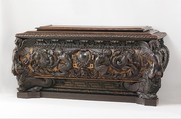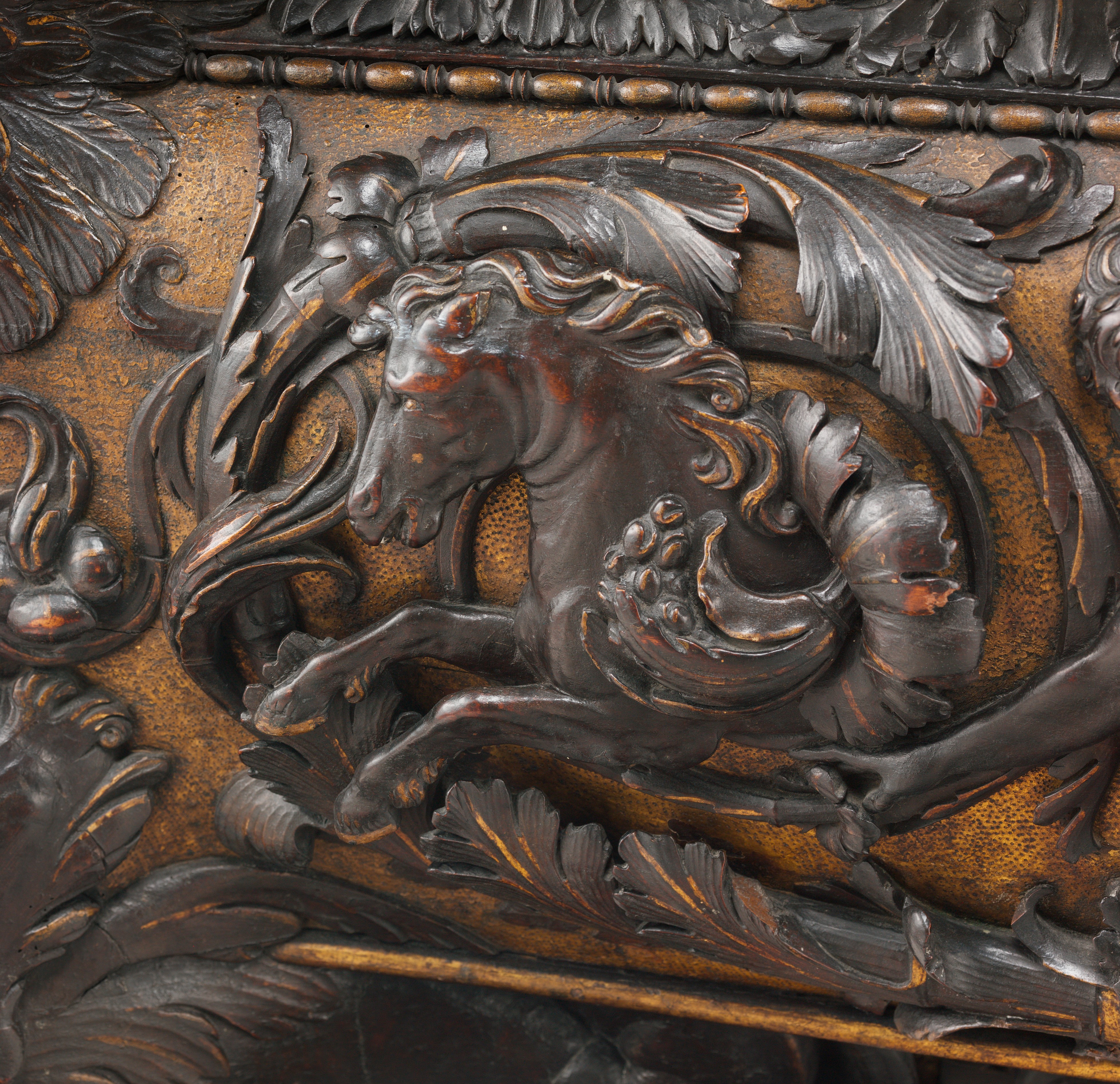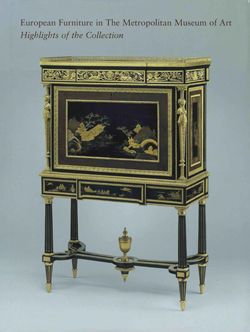Cassone (one of a pair)
Sumptuously ornamented chests called cassoni or forzieri played an important role in the wedding rituals of Renaissance Italy.[1] Between the thirteenth and fifteenth centuries, a woman's right to inherit from her parents and her husband diminished as society became more patriarchal. Accordingly, the dowry—the financial allotment she was given by her family on her marriage—increased in importance. In theory it was hers, but in reality the dowry was administered by her husband, who assumed responsibility to increase its value. Before the wedding, one or two pairs of chests were ordered and delivered to the bride's house, where they were filled with her marriage portion.[2] If, as was often the case, the bride was escorted in a formal procession from her parents' house to the bridegroom's residence, the cassoni were carried along as testimony to the wealth of the two families and the bond between them. When ordered in pairs, the chests could be decorated with the coats of arms of both houses. At princely weddings, the dowry might fill many cassoni of different sizes and styles of decoration. The bridal procession of Isabella d'Este (1474—1539) from Ferrara to Mantua in 1490 included no fewer than thirteen chests, which the Ferrarese court artist Ercole de' Roberti (ca. 1450–1496) had painted and also decorated with gold purchased in Venice.
Roman cassoni of the second half of the sixteenth century are characterized by skillfully executed relief carvings that either illustrate narratives, often after ancient Roman writers, or are lavishly ornamental. The latter is the case with the Museum's chest and its pair.[3] The two pieces differ only in a few details and slightly in their degree of preservation. In former times they could probably have been distinguished by the coats of arms painted on the front in the strapwork cartouches, but none of the polychrome decoration has survived. All the raised parts were once gilded, and this decoration has been partly preserved, albeit with much retouching. In both examples the layered plateaux of the lid are replacements.
The quality and the imaginative design of the carving are outstanding, clearly the work of a talented artist. Thus, the acanthus volutes in the frieze below the lid have been designed as three-dimensional handles, and the arms of the two satyrs are fully rounded, crowning the cartouches. The corner joints of the chest have been ingeniously concealed by winged caryatids seated on dolphins, each holding a grotesque mask between her lions' feet. The sarcophagus shape of the carcase, the classical meander band on the base, and the turbulent acanthus foliage reveal the designer's study of antique Roman monuments.[4] The intricately twisted satyr figures with asses' ears and angels' wings, whose goats' feet end in acanthus spirals, reflect prior knowledge of Michelangelo's inventions. The corner caryatids that emphasize the swelling body of the chest [5] recall the creations of Bartolommeo Ammanati (1511–1592), especially his fountain designs for the Villa Giulia, in Rome. The vigorous shapes of the acanthus tendrils with opening blossoms, from which the torsos of stallions energetically protrude, the rinceaux relief, and the crisply carved details evoke the designs of Perino del Vaga (1501–1547), thereby documenting the influence of Raphael's Logge for Pope Leo X at the Vatican on the artistic generation that followed[6]; however, the extreme Mannerist exaggeration of the composition's dynamics and the style of the figures are clear indication that the chest was created in Rome between 1550 and 1560.[7]
The delicately modeled snouts of the dolphins at the corners of the base, many of which are damaged, show that such chests needed a platform, such as the modern ones on which this pair rest today. Drawings and contemporary interior views prove the existence of pedestals in Renaissance times. An incredibly rare survival is a late-sixteenth-century drawing showing five alternative forms of chests, four of which are standing on differently molded bases, accompanied by an equally grand embellished cradle. Cradles were frequently given to a couple as a meaningful wedding gift, less often at the birth of their first child. The drawing was very likely part of a designer's model book, which he would show to a client as an indication of the variety of objects his workshop was able to create.[8]
The dolphin was associated with the sea god in classical times and became a symbol of long life. The creature is also shown as a companion of Venus (Venus marina), and as such is symbolic of love. As the companion of the seafaring Dionysus, the classical god of erotic ecstasy, this intelligent animal guaranteed safe travel. Given these attributes, what would be more fitting than to send a bride's dowry to her bridegroom in a pair of cassoni supported on the backs of dolphins? Bridal chests continued to be made in the seventeenth and early eighteenth centuries.[9] The Sèvres-porcelain-mounted jewel coffers on stand, of which Marie Antoinette received an example in 1770, the year of her marriage, is a playful development of this type of furniture at the end of the ancien régime in France (see 58.75.41).
[Wolfram Koeppe 2006]
Footnotes:
1. The text of this entry is adapted from Wolfram Koeppe. "French and Italian Renaissance Furniture at The Metropolitan Museum of Art: Notes on a Survey." Apollo 138 (June 1994); see also Wolfram Koeppe. "The Chest in the Italian and Central European Bedchamber from the Fifteenth to the Seventeenth Century." In The Bedroom from the Renaissance to Art Deco, comp. and ed. Meredith Chilton. Toronto, 1995, p. 15.
2. Peter Thornton. The Italian Renaissance Interior, 1400–1600. New York, 1991, p. 353, pl. 377; and Jerzy Miziołek. Soggetti classici sui cassoni fiorentini alla vigilia del Rinascimento. Warsaw, 1996, pl. 3.
3. The accession number of the pair to this chest is 55.197.
4. Similarly inspired by the decoration on classical Roman monuments is the Farnese table (58.57a–d); for another sarcophagus-shaped chest with acanthus decoration, see John Morley. The History of Furniture: Twenty-five Centuries of Style and Design in the Western Tradition. Boston, 1999, p. 107, fig. 184.
5. For a similar example, see ibid., p. 107, fig. 187.
6. On acanthus rinceaux, see Ursula Reinhardt. "Acanthus." In The History of Decorative Arts: Classicism and the Baroque in Europe, ed. Alain Gruber, pp. 93–155. Trans. John Goodman. New York, 1996, pp. 97, 104. On Raphael's Logge decorations, see Maurizio Fagiolo dell'Arco, ed. The Art of the Popes from the Vatican Collection: How Pontiffs, Architects, Painters, and Sculptors Created the Vatican. Milan, 1983, p. 261. On Perino del Vaga, see The Dictionary of Art. Ed. Jane Turner. 34 vols. New York, 1996, vol. 24, pp. 419-20 (entry by Richard Harprath).
7. A comparably dramatic corner design with caryatids of somewhat lesser quality characterizes a cassone in the Manchester City Art Galleries (Manchester City Art Gallery. A Century of Collecting, 1882–1982: A Guide to the Manchester City Art Galleries. Manchester, 1983, p. 52, no. 35), and a cassone with similarly lush acanthus foliage can be seen in the Musée des Arts Décoratifs in Paris (Ursula Reinhardt. "Acanthus." In The History of Decorative Arts: Classicism and the Baroque in Europe, ed. Alain Gruber, pp. 93–155. Trans. John Goodman. New York, 1996, p. 101).
8. Related chests are illustrated in a drawing in a private New York collection (Ellen Callmann. Beyond Nobility: Art for the Private Citizen in the Early Renaissance. Exh. cat., Allentown Art Museum. Allentown, Pa., 1980, p. 35, no. 29) and in another in the Lodewijk Houthakker collection (Peter Fuhring. Design into Art– Drawings for Architecture and Ornament: The Lodewijk Houthakker Collection. 2 vols. London, 1989, vol. 1, p. 334, no. 510).
9. Charissa Bremer-David, with Peggy Fogelman, Peter Fusco, and Catherine Hess. Decorative Arts: An Illustrated Summary Catalogue of the Collections of the J. Paul Getty Museum. Rev. ed. Malibu, 1993, p. 3, no. 4.
Due to rights restrictions, this image cannot be enlarged, viewed at full screen, or downloaded.
This artwork is meant to be viewed from right to left. Scroll left to view more.






